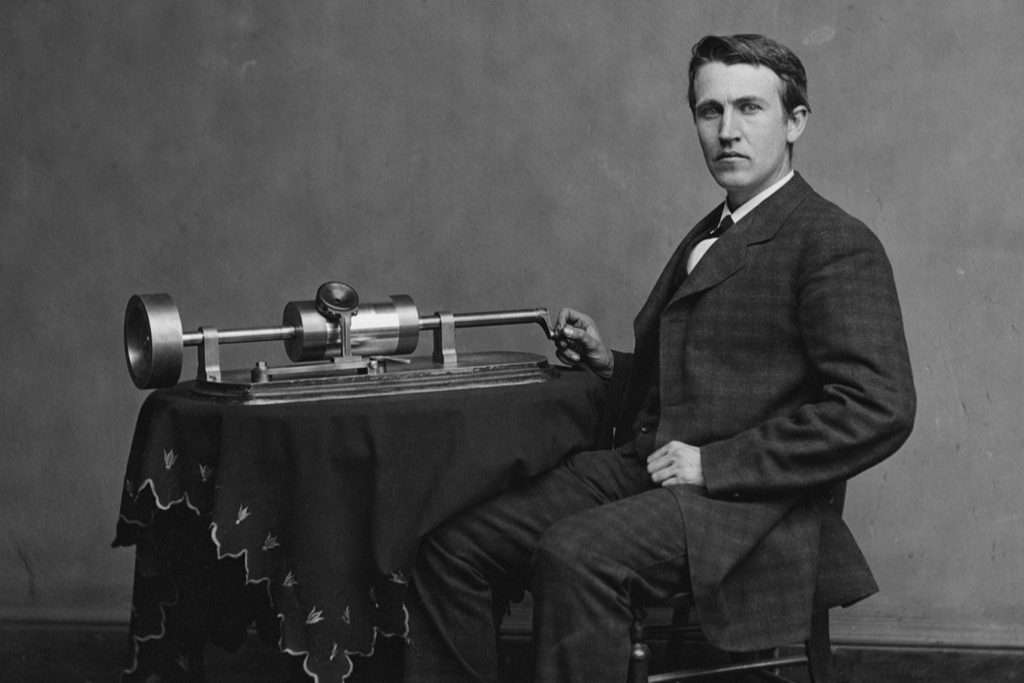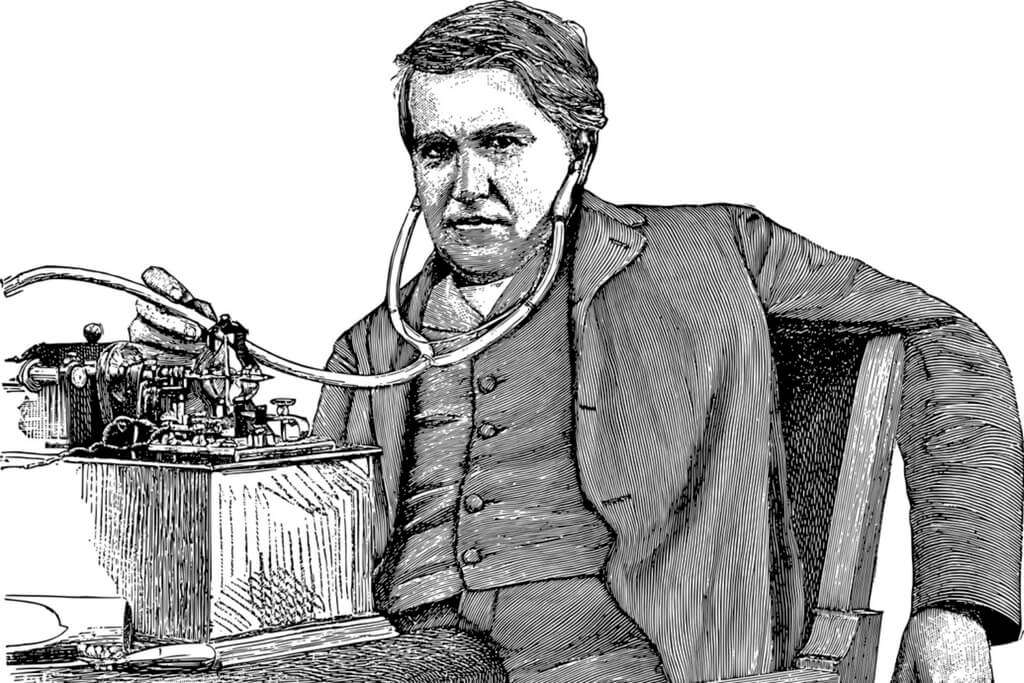Thomas Edison, a towering figure in the annals of human ingenuity, is a testament to the power of invention and innovation. With a relentless pursuit of knowledge and a sincere dedication to solving the world’s problems, Thomas edisons inventions contributions have left an indelible mark on modern society. inventions This article embarks on a captivating journey through time, delving into the profound impact of Edison’s inventions and their enduring relevance in shaping our world today.

The Light Bulb: Illuminating Our Lives
Edison’s crowning achievement, the incandescent light bulb, was revolutionary. Before Edison’s breakthrough, the world was cast into darkness once the sun set, limiting human activity to daylight hours. Introducing electric lighting shattered this constraint, ushering in a new era of productivity, convenience, and leisure. No longer confined by the constraints of natural light, individuals could work, read, and engage in recreational activities long into the night. While modern advancements have given rise to LED and energy-efficient lighting, the foundational principle of Edison’s invention continues to radiate through our lives, underscoring the essential role of lighting in our daily routines.
The Phonograph: Giving Voice To The Past
Thomas edisons inventions of the phonograph, a remarkable feat of engineering, granted humanity the power to capture and reproduce sound. This monumental invention not only transformed how we communicate but also opened the door to preserving history. While the phonograph of Edison’s era may appear rudimentary compared to today’s sophisticated audio technology, its significance is immeasurable. It sowed the seeds for subsequent innovations, including magnetic tape, vinyl records, compact discs, and digital audio formats. The resurgence of vinyl records in recent years is a testament to the enduring appeal of analog sound, bridging the gap between past and present. Moreover, digitizing historical audio archives ensures that voices from bygone eras continue reverberating, enabling future generations to connect with the past on an intimate auditory level.
The Motion Picture Camera: Capturing Time In Motion
Edison’s contributions to motion picture technology forever altered the trajectory of visual storytelling. The kinetoscope, a marvel of innovation in its time, laid the cornerstone for the future cinematic revolution. With Edison’s motion picture camera, capturing fleeting moments in time and projecting them onto screens became a reality. This breakthrough ignited a spark of creativity that has evolved into the complex and sophisticated filmmaking techniques we witness today. From the silent films of the early 20th century to the sprawling cinematic universes of contemporary blockbusters, Edison’s vision of capturing time in motion continues to serve as the bedrock upon which the global film industry thrives.

Electricity Generation And Distribution: Powering Progress
Edison’s influence reverberates far beyond the realms of illumination and entertainment. His pioneering work in electricity generation, transmission, and distribution laid the groundwork for the modern power systems that underpin our technologically driven society. Edison’s development of direct current (DC) and alternating current (AC) technologies sparked a monumental rivalry that shaped the future of electricity distribution. While the current battle between AC and DC has been decisively won by alternating current, Edison’s legacy endures through the intricate web of electrical grids that power our homes, industries, and digital devices. As the world shifts towards sustainable energy solutions, Edison’s fundamental principles continue to guide the evolution of renewable energy sources, smart grids, and energy-efficient technologies.
Legacy And Continued Influence
Beyond tangible inventions, Thomas Edison’s legacy embodies a spirit of unyielding innovation and resilience. His relentless pursuit of progress in facing challenges is a beacon for modern inventors and researchers. Educational programs and initiatives dedicated to honoring Edison’s contributions inspire future generations to cultivate a mindset of curiosity, exploration, and problem-solving. Edison’s journey reminds us that the path to innovation is fraught with obstacles, but it is precisely through these challenges that humanity propels itself forward. His legacy encourages us to embrace failure as a stepping stone to success, think beyond conventional boundaries, and kindle the flames of creativity, illuminating the path toward a brighter future.

In the tapestry of human history, Thomas Edison emerges as a luminous thread, weaving his inventions into the very fabric of our lives. From the incandescent glow that banished darkness to the captivating narratives that flicker on screens, Thomas edisons inventions and creations remain vital conduits through which we experience the world. As we reflect on the profound impact of his innovations, we are beckoned to honor the legacy of inventors like Edison, to treasure the spirit of innovation that propels humanity forward, and to kindle the fires of imagination that illuminate the path toward progress. Edison’s legacy is not merely a historical artifact but a guiding star that inspires us to reach new heights and transform the future.
When Did Thomas Edison Invent The Kinetoscope?
In the realm of technological marvels and groundbreaking inventions, Thomas Edison stands as a luminary, leaving an indelible mark on the course of human history. Among his vast array of contributions, the invention of the Kinetoscope remains a pivotal moment in the evolution of entertainment and cinematography. As we delve into the annals of history, let’s unravel the story of when Thomas Edison brought the Kinetoscope into existence and how it paved the way for the cinematic revolution.
The Prelude To Edison’s Cinematic Endeavor
In the late 19th century, the world was on the brink of a technological renaissance, with inventors and innovators striving to unlock new realms of possibilities. Thomas Edison, already celebrated for his groundbreaking inventions such as the phonograph and the electric light bulb, had an insatiable curiosity that led him to explore the realms of motion pictures. It was in this spirit of exploration that Edison set the stage for what would become the Kinetoscope.
The Birth Of The Kinetoscope
The year was 1888 when Edison began experimenting with the idea of a motion picture device. His goal was to create a mechanism that could capture and reproduce moving images, thus bringing a new dimension to visual storytelling. After years of experimentation and refinement, Edison unveiled the Kinetoscope in 1891, forever changing the landscape of entertainment.

The Mechanics Of The Kinetoscope
At its core, the Kinetoscope was a motion picture projection system that utilized a series of still photographs to create the illusion of continuous motion. Edison’s invention relied on a spool of perforated celluloid film, driven by a motorized sprocket system. As the film moved through the mechanism, viewers could peer through a peephole to witness the magic of moving images.
The First Public Demonstration
Edison, always the showman, organized the first public demonstration of the Kinetoscope on May 20, 1891. The event took place at the Brooklyn Institute of Arts and Sciences, where a small audience gathered to witness history in the making. The short film, featuring images of a dancer and various everyday scenes, captivated the audience and left them in awe of Edison’s ingenuity.
The Commercialization Of The Kinetoscope
Recognizing the immense potential of his invention, Thomas Edison moved swiftly to commercialize the Kinetoscope. In 1893, he formed the Edison Manufacturing Company, which became the epicenter of his cinematic endeavors. The company produced a series of short films to be viewed on the Kinetoscope, marking the birth of the motion picture industry.
Thomas Edison’s Inventions Take Center Stage
Edison’s inventive genius was not confined to a single domain; rather, it manifested in a myriad of groundbreaking creations. Thomas Edison’s inventions, ranging from the incandescent light bulb to the phonograph, had already revolutionized the world. The Kinetoscope, however, added a new dimension to Edison’s legacy, solidifying his status as a pioneer in the world of entertainment technology.

The Kinetoscope Goes Global
The success of the Kinetoscope spread beyond American shores, captivating audiences worldwide. Edison’s inventions had a global impact, and the Kinetoscope was no exception. As the technology spread, similar devices and innovations emerged in Europe and other parts of the world, contributing to the international growth of the motion picture industry.
Challenges And Controversies
While the Kinetoscope was a marvel in its own right, Edison’s foray into the cinematic realm was not without its challenges and controversies. The system’s reliance on individual viewing through a peephole limited its audience reach, prompting competitors to explore alternative projection methods for larger audiences. This led to the development of the cinematograph by the Lumière brothers in France, presenting a new chapter in the history of motion pictures.
Legacy And Impact
Despite the challenges, the Kinetoscope left an indelible mark on the evolution of cinema. It laid the groundwork for subsequent advancements in film technology, shaping the trajectory of the entertainment industry for decades to come. Edison’s inventive spirit, coupled with his entrepreneurial vision, set the stage for the cinematic revolution that would unfold in the 20th century.
In the grand tapestry of Thomas Edison’s inventions, the Kinetoscope stands as a testament to his insatiable curiosity and innovative spirit. The year 1891 marked a pivotal moment in the history of entertainment, as Edison unveiled a device that would redefine how the world experienced motion pictures. The Kinetoscope, with its mesmerizing moving images, opened the door to a new era of storytelling and paved the way for the cinematic wonders we enjoy today. Thomas Edison’s inventions, including the Kinetoscope, continue to inspire generations, reminding us of the transformative power of human ingenuity.
When Did Thomas Edison Invent The Phonograph?
In the pantheon of inventors who have shaped the course of human history, Thomas Edison stands as a towering figure. His inventive genius and entrepreneurial spirit left an indelible mark on the world, with one of his most groundbreaking creations being the phonograph. In this exploration, we embark on a journey through time to uncover when Thomas Edison brought the enchanting melody of the phonograph into existence.
The Prelude To Sonic Innovation
The late 19th century was a period of technological ferment, with inventors feverishly exploring avenues to capture and reproduce sound. Edison, already renowned for his role in revolutionizing electric lighting, sought to conquer the realm of audio with a device that could record and play back sound. This quest laid the groundwork for what would become one of Thomas Edison’s most celebrated inventions—the phonograph.

Edison’s Inventive Vision
The spark of inspiration for the phonograph came to Edison during a moment of contemplation about the nature of sound. In 1877, he envisioned a machine that could mechanically reproduce the vibrations of sound and play them back at a later time. This ambitious vision marked the genesis of the phonograph, a device that would bring the world into a new era of audio entertainment.
The Birth Of The Phonograph
Thomas Edison’s tireless experimentation and refinement of his ideas led to a pivotal moment in the winter of 1877 when he successfully created a working prototype of the phonograph. On December 6, 1877, Edison filed for a patent for his invention, forever securing his place in history as the father of recorded sound.
The Mechanics Of Sound
At its core, the phonograph was a marvel of mechanical ingenuity. The device featured a rotating cylinder wrapped in tinfoil, onto which a stylus traced the vibrations of sound waves. As the cylinder rotated, it could reproduce the recorded sound when the stylus retraced its path. This revolutionary mechanism transformed the ephemeral nature of sound into a tangible and reproducible form.
The First Public Demonstration
Edison, always the showman, unveiled the phonograph to the public in 1878. The first demonstration took place at the offices of Scientific American, where a captivated audience witnessed the miraculous playback of Edison’s recorded voice. The phrase “Mary had a little lamb” resounded through the room, leaving those in attendance astonished and filled with wonder at the possibilities that lay ahead.
Commercialization And Public Reception
Edison’s inventions were not merely confined to the laboratory; he was a savvy entrepreneur who understood the commercial potential of his creations. The phonograph, with its ability to capture and reproduce sound, quickly garnered public attention. In 1878, Edison established the Edison Speaking Phonograph Company to manufacture and sell his invention, making it the first-ever company dedicated to recorded sound.

Thomas Edison’s Inventions Transform Communication
As the phonograph gained popularity, it became a cultural phenomenon, transforming the landscape of communication. Thomas Edison’s inventions, including the phonograph, bridged gaps and brought people together through the shared experience of recorded sound. From the spoken word to music, the phonograph revolutionized how information and entertainment were disseminated, laying the groundwork for the modern music industry.
Evolution Of The Phonograph
The initial tinfoil-wrapped cylinders of the phonograph were soon replaced by more durable and practical materials, such as wax and later, celluloid. This evolution in recording technology allowed for longer and higher-quality recordings. The phonograph became more accessible to the masses, with a growing variety of recordings available for public consumption.
Challenges And Competing Technologies
While the phonograph represented a groundbreaking leap in audio technology, it was not without its challenges. Competing technologies, such as Emile Berliner’s gramophone, emerged as formidable contenders. Berliner’s invention utilized flat discs instead of cylindrical records, leading to a format war that ultimately contributed to the demise of the tinfoil-wrapped cylinder in favor of the flat disc.
Legacy Of The Phonograph
Despite the challenges and competition, the phonograph left an enduring legacy. Thomas Edison’s inventions, including the phonograph, fundamentally altered the way people experienced and interacted with sound. The phonograph laid the foundation for the recording industry, creating a cultural shift in the consumption of music and spoken word. Its impact reverberated through the 20th century and beyond, shaping the trajectory of audio technology.
Final Thoughts
In the history of innovation, the invention of the phonograph by Thomas Edison stands as a watershed moment. The ability to capture and reproduce sound marked a transformative leap in the realm of communication and entertainment. Edison’s tireless pursuit of ingenuity, coupled with his entrepreneurial spirit, led to the creation of a device that would echo through the corridors of time. The phonograph not only revolutionized the way we experience sound but also paved the way for the audio technology that defines our modern world. As we celebrate Thomas Edison’s inventions, the phonograph remains a testament to the power of human curiosity and the enduring impact of visionary inventors.
Also Read: What Happened After Thomas Edison Invented The Lightbulb?
